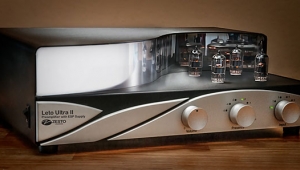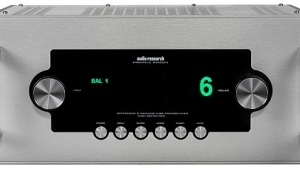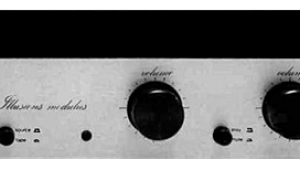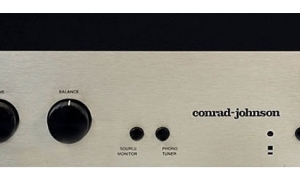| Columns Retired Columns & Blogs |
Conrad-Johnson PV9 preamplifier Page 2
A word is in order concerning the PV9's tape-monitor arrangements, which are identical to those on earlier C-J preamplifiers. As well as the rotary source switch, which can select the Tape 1 or Tape 2 inputs, there are two pushbuttons, one switching the tape monitor input between Tape 1 and Tape 2, the other selecting Source or Monitor. Whatever source is selected with the rotary control is present on both pairs of tape output sockets. It may be my CD-befuddled brain, but I find these controls to be counter-intuitive. More important, they allow the possibility of positive feedback since the signal from a selected tape-deck output will also be fed to its own input.
Footnote 2: Stereophile's "Almost All-Tube Issue," Vol.7 No.3.
This will not normally present a problem, but if you have a three-head deck with its own source/monitor switch set to source, or a two-head deck set to record, selecting that deck with the rotary switch will lead to feedback. Conrad-Johnson warns against this in the PV9's handbook—the danger of howl-around also exists with external signal processors used in one of the tape loops—and to minimize the chance of feedback, it would be best always to put the tape deck most often used for recording or the signal processor in Tape Loop 2, so that you don't have to switch through it to reach the other tape input. I must say, however, that I think it awkward design, if not altogether dumb. Presumably it is arranged in this manner so that the two tape inputs can also double as conventional line-level inputs, but, in my opinion, this is most definitely not an optimal solution.
There are no other controls, the PV9 omitting the stereo mode switch that appeared on the previous generation of C-J preamplifiers, as well as on the PV8.
The Sound
The PV9 was used for about four weeks' worth of everyday listening, as well as for my loudspeaker reviews elsewhere in this issue. As well as the Vandersteen 2Ci and Celestion SL600Si loudspeakers, I also used the Celestion SL700 and Rogers LS3/5a speakers for some of the auditioning. The loudspeakers were connected with Monster M1; interconnect was AudioQuest LiveWire Lapis. Source components consisted of a Linn Troika/Ekos/Sondek LP player sitting on a Sound Organisation stand, the new Philips LHH1000 two-box CD player, its transport section also used to drive the Sony DAS-R1 D/A convertor, and my venerable Revox A77 open-reel recorder.
Regarding the choice of cartridge, I admit right from the start that the PV9's phono input is optimized for high-output MC or MM cartridges. I do have a second Linn set up with a Linn K-9 MM cartridge, one of Stereophile's Class C recommendations, but to be frank, upon trying it with the PV9, it was obviously outclassed. I therefore did some listening with the Troika's output voltage magnified by the Tim de Paravicini-designed HFN/RR Black Head transformer, but for the bulk of my listening I used the Troika straight in, the noise being just low enough for me to get away with it, more so with the insensitive Celestions than with the Vandersteens. (The transformer noticeably degraded low-frequency control, as well as restricting soundstage depth. With the Vandersteens, it also resulted in restricted volume-control travel.) Hum aside, the noise via the phono input was very "pink," having an inoffensive soft, rushing character rather than an irritating HF peaky nature.
The problem here is whether you regard it the reviewer's duty to put together an optimally matched system around the component under review, or whether to stick with components with which the reviewer is familiar enough that a valid description of the test component's sonic attributes can be arrived at. In an ideal world, every reviewer would aim at the former, yet it is also true that changing more than one component at a time inevitably leads to confusion. I therefore focus my auditioning on the identification of the review component's sound; that way, owners and prospective purchasers can see if it fundamentally fits in with their tastes or not, and develop a shortlist of possibly complementary ancillaries.
Power amplification was initially provided by a pair of VTL 100W Compact Monoblocks. Using the Vandersteens, these proved to be far too sensitive for sensible use with the PV9, however, and their slight midrange forwardness didn't meld at all well with the intrinsic nature of those loudspeakers. I therefore conducted all my serious listening with my 1986-vintage Krell KSA-50, which both permitted a better estimation of the PV9's low-frequency performance, and allowed its volume control to be used in a sensible part of its range, between 8 o'clock and 12 o'clock for CD and 10 o'clock and 2 o'clock for LP (when the preamp was used with the Vandersteen speakers).
C-J's Premier Three preamplifier was the stimulus for Anthony H. Cordesman's famous comparison: "The [Audio Research] SP-10 brings you closer to the music. The C-J is twentieth row center" (footnote 2). He didn't list in his review what recordings enabled him to reach this conclusion, but it has proved true as a guide to the nature of the traditional Conrad-Johnson sound: rather laidback, the highs suggesting a slight rolloff, as would be natural from a seat a little farther back in the house.
This was precisely the overwhelming signature of the PV9 via the phono input. A wealth of detail was apparent, with astonishingly accurate image depth on recordings that possess the informational wherewithal. On the Performance Recordings James Boyk piano LPs, for example, the Steinway was set well back within the dome of Caltech's Dabney Hall ambience. Having heard Jim play there on the same piano, the sound via the tubed PV9 when reproduced over Celestion SL700s was astonishingly lifelike, even small details of the piano sound and the performance being made clear. But that detail was not pushed forward at the listener in any way. Rather, as in real life, it was there when you needed it. I gained a suspicion that the image was a little less wide than I am used to via my reference preamplifier, but I wasn't consistent at identifying this.
Again via the phono input, the low frequencies were full, even too full when compared with the same recordings on CD. With the Celestion SL600s, this resulted in a sound that was too overblown, but with the Vandersteens, the result was a satisfyingly rich flavor to the bass. To draw a parallel with one my favorite interests—dessert—the Celestion/PV9 combination was profiteroles with just too much chocolate sauce (footnote 3), while the Vandersteen/PV9 had just the right amount of chocolate to allow the delicate flavor of the choux pastry to shine through.
The highs were where the PV9 scored its highest points: delicate, unexaggerated, with instruments having just the right amount of edge to their sounds to allow their individualities to come through. I suppose that this is what that veteran tubeophile Dick Olsher would refer to as "tube sound." Well, I was certainly taken with it. Having used mainly solid-state designs for the last couple of years, perhaps it appears that the tube, or at least the triode, is still the best device for amplifying the output of an MC cartridge.
Lest you think I am ignoring the wood for all the interesting trees, the PV9's greatest strength via its phono input was the ability to blend all of these individual aspects together to form a musical whole. As with the Audio Research SP10 (which in my opinion was the greatest preamplifier ARC ever made), one LP just seemed to lead to another.
That's what it's all about, isn't it? It reminds me of something said by one of Stereophile's regular listening team here in Santa Fe, Michael Mandell, when he was listening to the PV9 over at my place one Saturday morning. Michael used to use a C-J PV5 but has recently replaced it with a Threshold phono amplifier/Mod Squad Line Drive combination. "You know," he said, "I am convinced that my current set-up is more accurate. But listening to the PV9 reminds me that I don't seem to enjoy my records as much as when I used the PV5."
That, I feel, is the essence of the whole debate that has been raging in these pages between J. Gordon Holt and myself. The typical solid-state phono preamplifier may be accurate regarding its portrayal of the surface characteristics of music, but a good tube design—and I have to add the modifier, there being a number of poor tube designs where it seems to be assumed that mere use of tubes will magically override any other shortcomings—somehow seems to be more true to the underlying nature of the music. Of course, there are solid-state exceptions—the Vendetta Research phono preamplifier, the Mark Levinson No.26, and the Mod Squad Phono Drive in effect combine the best of both worlds—but the PV9's almost archetypical portrayal of the benefits brought to LP replay by tube technology brings matters to a head.
Turning to the line stage, here I was able to carry out both comparisons with my reference Mod Squad Line Drive Deluxe, and to try some bypass tests, using my own master tapes as source. Here, the PV9 was not as impressive, for the signature it imposed on the sound detracted rather than added to the musical whole. Again, the somewhat narrow but deep stage was identifiable; again, the highs were sweet and the bass full. But the fact that I could detect these characteristics at all worried me, as surely the passive device (when used with short, low-capacitance interconnects) must be both more neutral and more musically accurate. Even if ultimately less enjoyable.
Mustn't it?
Again, the PV9 brings such philosophical matters to a head. Whereas I would confidently recommend it for LP replay (provided the correct balance can be struck between cartridge and loudspeaker choice, thus arranging whether the noise level will be audible or not), I would stick with the Mod Squad control center for CD and tape replay.
You know what I would like C-J to produce: the PV9's phono stage on its own, the tube equivalent of the Vendetta or Mod Squad phono preamplifiers. That might give audiophiles the best of both worlds.
Conclusion
Beautifully constructed, with high-quality components used throughout, Conrad-Johnson's PV9 is the very epitome of a modern all-tube preamplifier. I must admit that I started the review feeling irritated with what I felt to be arbitrary design idiosyncrasies: its lack of a true MC input; its perverse tape-monitor arrangements; its too-high sensitivity on its line inputs, leading to a restricted action on the volume control; and a line stage that was not as neutral as I would have thought essential at this price level. Yet, as record followed record and CD followed CD, even I had to own up that I was enjoying everything I heard. As the garage-sale incident indicates, my LP-buying habit started to increase in frequency—always a good sign that something good is happening—and I was truly sorry when the PV9 had to be replaced in its shipping carton.
The PV9's tonal balance will require some care in choosing components that will complement rather than reinforce its own idiosyncrasies. It matched the Vandersteen 2Ci's much better than it did the Celestion SL600Si's, for example, the latter combination being too dark too much of the time. It will also mate well with cartridges that are themselves rather forward in balance; the Talisman Virtuoso DTi, for example. Me, I find myself playing CDs often enough that I find the degree of line-level transparency coupled with neutrality offered by the Mod Squad's Line Drive Deluxe to be essential. But if you favor LP over CD, and use a reasonably high-output MC cartridge, then the PV9 will offer a consistently musical performance commensurate with its high price.
Footnote 2: Stereophile's "Almost All-Tube Issue," Vol.7 No.3.
Footnote 3: My wife would like to state for the record that there is no such thing as "too much chocolate."
- Log in or register to post comments




































